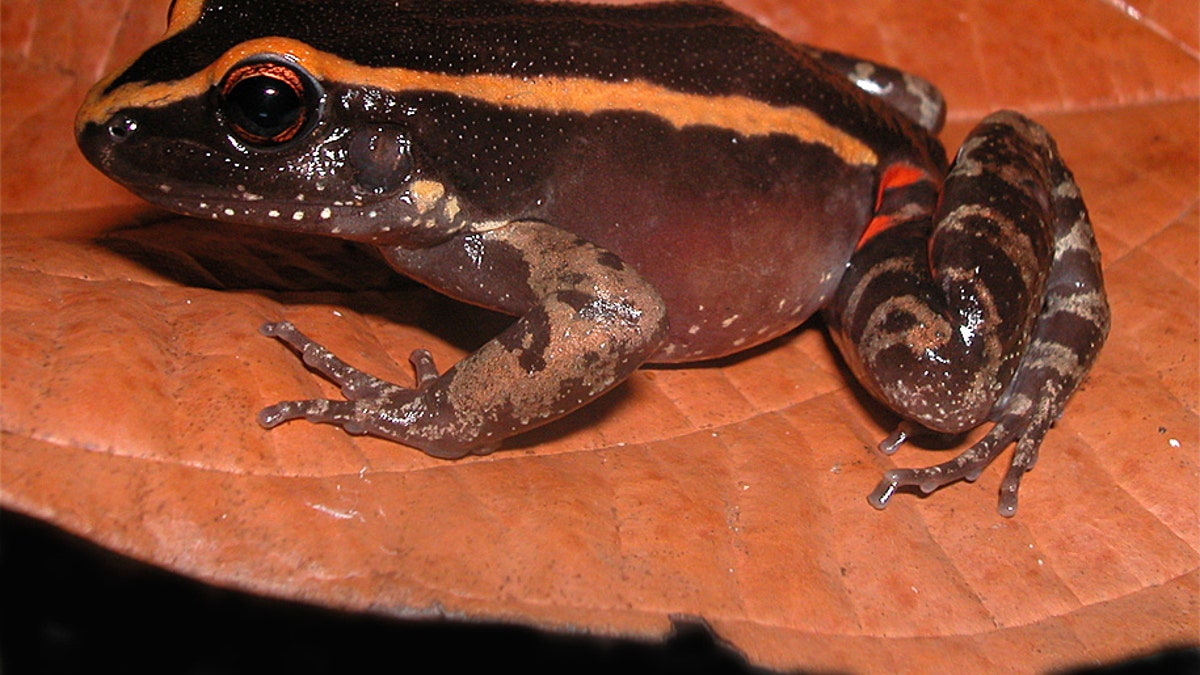
Lithodytes lineatus (Credit: Albertina Pimentel Lima)
Frogs and ants living together– it’s like nature’s version of “The Odd Couple”. A yellow–striped frog in the Amazon rainforest is able to live among the vicious leaf–cutter ant without getting torn to pieces thanks to a very special bug repellent: its own skin. The frog, known as Lithodytes lineatus, releases a chemical that tricks the ants into ignoring it.
In South America’s Amazon region, leaf–cutter ants communicate with one another via pheremones. Their pincers are razor–sharp, and if outsiders are detected around the colony the ants tear the intruders apart. Frogs pose no threat to the ants as a predator, but apparently the leaf–cutters didn’t get the memo.
“Our observations have shown that leaf cutting ants are highly aggressive with other species of frogs– the attacks are so aggressive that they can kill these individuals in a few minutes,” Andre Barros of the National Institute of Amazonian Research in Brazil told FoxNews.com. “As these ants are not carnivorous the aggression is only for protection and as soldiers have very robust jaws, potential intruders are quickly immobilized (depending on the amount of attacking soldiers).”
Related: Hurricane Matthew unearths huge prehistoric shark tooth
Barros’ team set out to find why the ants chose to ignore Lithodytes lineatus. They placed frogs from five different species, including Lithodytes lineatus, in a glass container near the entrance of an ant nest. All of the frogs tried to escape with the exception of the yellow–striped Lithodytes, who remained cool as a cucumber.
“The experiment had a maximum duration of ten minutes,” Barros, who led the study, said. “After such time, the frogs were removed and the number of ants attached to their skin was counted. We observed that leaf-cutting ants of genus Atta did not attack frog L. lineatus, but aggressively attacked other anuran [amphibian] species.”
Next, the team placed 20 Rhinella major frogs within the ant nests. Ten of the frogs were covered with Lithodytes lineatus skin extract, and the other ten with ultrapure water. As predicted, the frogs given the extract were left alone while the ones doused with water were attacked.
Related: Watch a baby elephant 'rescue' a man in a river
According to Barros, the ant–repelling skin of L. lineatus has chemical properties that keep the little critters from attacking, though it’s unknown what exactly these properties are. “We cannot yet say [what] these biomolecules are (enzymes, peptides, proteins or others), but it was evident that there is a chemical signal produced in the frog skin that allows that they remain alive in anthills,” he said. “Furthermore, it was observed that this signal is recognized by more than one species of Atta ants.”
It’s suggested that the anthills’ stable microclimate and higher humidity level provides the frogs with a better reproduction and breeding environment, though it’s only a speculation at this point. In any event, this remains an exciting find in the amphibian world. Cases of frogs and ants living together have been documented, but this is the first time it’s been known to happen on this side of the Atlantic.
Related: Viral video shows great white shark breaking into dive cage
“A similar trait is known to some species of frogs in Africa that live with ants, but until now, Lithodytes lineatus is the only species of frog in the Americas known to breed and build nests in the ant's nests, suggesting a complex process of co–evolution or a sophisticated chemical disguise,” Barros said. “We are really excited with our results and other research is being conducted to better understand this system.”
